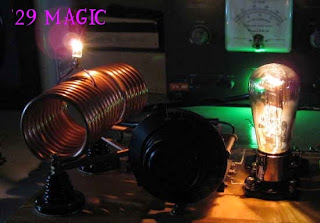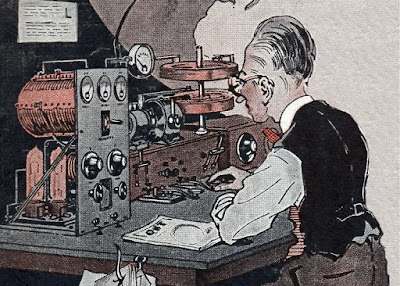Posts Tagged ‘BK’
 1929 QSO Party Weekends
1929 QSO Party Weekends
This Saturday as well as the next will be the annual Bruce Kelley 1929 QSO Party, otherwise known as the '1929 BK'.
It's the once a year opportunity to celebrate the sounds of early amateur radio ... only transmitters that are 'era-appropriate' are allowed to be used. More specifically, transmitters must employ tubes that were available in 1929 or earlier, and transmitters must be self-excited. No crystals allowed! Crystals were new and largely unaffordable for most hams back in the depression days.
1929 marked a real turning point in amateur radio as governments finally cracked-down on things such as frequency stability, out of band operations and re-alignment of call districts. In short, hams were henceforth required to behave themselves and to clean up their signals and methods of operation.
 |
| courtesy: http://www.arrl.org/ |
If you tune across the CW bands during the next two Saturday nights, you will have the rare opportunity to hear exactly what the bands must have sounded like back in the early '30s'.
For the most part you will hear single tube Hartley, Colpitts or TNT oscillators with a few two-tube MOPAs' thrown in. Many of them will suffer the same problems encountered by the boys of '29 ... chirp, drift, buzzy notes and frequency instability from antennas swaying in the wind. The MOPAs' will sound much better but some surprisingly nice-sounding signals can be heard coming from properly tuned and optimised single-tube oscillators. I recall being blown away by the lovely sounding signal I heard from such a rig when first tuning into the BK activity several years ago, only to learn that it was a self-excited Hartley using 1/4" copper tubing for the oscillator tank circuit!
The '29 watering-hole on 80m will be around 3550-3580 kilocycles (be careful not to confuse this with kilohertz!) while the early afternoon to sunset 40m activity will be found from 7100-7125 kc. There may even be a few on the very low end of 160m, later on the first Saturday night only. Although many of these transmitter styles were used on 20m and higher, BK rule-makers have wisely decided not to inflict these sounds on the present populace as it would likely keep the 'Official Observer' guys busy for several days writing pink-slips.
You can learn more about amateur radio happenings leading up to and following the 1929 crackdown in my earlier series of 'Why '29' blogs here:
Part 2
Part 3
Part 4
Those wishing to put something together for next year's event can find everything needed here:
Building '29-Style - Part 1
Building '29-Style - Part 2
Unfortunately due to a number of coinciding events, I'll not be on-the-air for the event this year, the first one I've missed since getting in on the fun several years ago.
 Getting Ready For The ’29 QSO Party
Getting Ready For The ’29 QSO Party

Although the Bruce Kelly 1929 QSO Party is not until December, now is really the time to be putting something together if you've been thinking about getting in on the fun this year!
Like almost all of the operating in 1929, this is a CW only affair and if you've taken a listen in previous years, you know that the chirps, yoops, sudden frequency excursions and musical notes are all part of the original difficulties faced by the boys of '29 as they struggled with the relatively new adventure of 'amateur radio'.
Why 1929 you ask? It was the Radio Act of 1927 that came into effect in 1929 that laid out the foundation and future of amateur radio, with most of the early tenets still in effect today. The BK QSO Party celebrates the turning point in what had been pretty much a radio 'free-for-all' up until that time. Real progress was made quickly once the ground rules were established.
Rules of the BK Party require that all transmitters use tubes that were available in 1929 or earlier and must be self-excited ... no crystals allowed! This might seem to present a daunting task but in reality there are many readily available tubes that will make your transmitter legal.
In three previous blogs I've outlined some of the construction options available to new BK entrants and you can probably find enough information there to get you well on your way to some mid-winter fun. You will find links to these on the sidebar to the right.
Over the past three years I have posted a lot of 1929-related material, covering construction as well as BK Party activity. You can get all of these '29 blogs here and get enough bedtime reading for the week and hopefully, enough inspiration to grab the soldering iron and think about throwing something together for the party ... and it doesn't have to be pretty, as long as it works and is 'legal'! As well, my website has detailed construction information for three of my own '29-style transmitters.
I'm always impressed with the level of operating seen in the BK Party. For some reason, these guys can copy the weakest most awful sounding signals with ease. If you can get something going with a couple of watts or more, I guarantee that you will be heard and will work many of the '29 stations ... just don't wait to late to start building as I'd hate for you to miss all the fun!
 ’29 BK QSO Party – Night #2
’29 BK QSO Party – Night #2
Weekend #2 for the 1929 Bruce Kelley QSO Party found propagation even poorer than the first weekend.
With the 'K' index rising to level 4 along with the arrival of high speed solar winds, it was an uphill battle once again. And as usual, the terrestrial winds were relentless at 60-90km/h here for the entire event ... the worst winds I have experienced during any previous BK's.
The new MOPA did not suffer from the same level of frequency jumping as my previously used Hartley or TNT oscillators but the high winds were still able to cause some melodic pulling of the oscillator. Apparently there is still enough trickle-down coupling from the PA to the oscillator when high winds cause sudden shifts in impedance or resonance of the antenna ... but generally I was much happier with the new BK transmitter.
This year's BK QSO total was the lowest I have had, with just 29 QSO's. A few more were added on Saturday night as well as early Sunday morning, including one QSO on topband.
KK7UV, Steve in Montana, can always be counted on for a clean-sweep and working him on 160m completed that task again this year. Steve's extensive fall antenna work has really payed off as his '29 signal was always impressive up this way. His 160m Hartley signal was a solid 579.
 |
| KK7UV - Hull Hartley |
Hats off to Bill, K4JYS in North Carolina, as once again his signal seemed to be the one most consistently heard here, on both 40m and 80m. Bill runs a single-wire off-center fed Hertz at 40', as described in December 1929 QST and it seems to work very well.
 |
| K4JYS - 210 Hartley |
George, N3GJ in Pennsylvania was worked along with Larry, W2LB in New York. Larry's 5W Hartley signal was an amazing 559 and solid copy. His breadboard '29 rig is proof that it doesn't have to be pretty to do the job and join the fun!
| W2LB - 227 5W Hartley |
Another one of the night's highlights was working Lou, VE3AWA, on 80m, who I had missed the previous weekend. So far, Lou and I have never failed to work each other on 80m but it was looking rather dire until his signal suddenly popped-up shortly before 8PM, keeping our record intact.
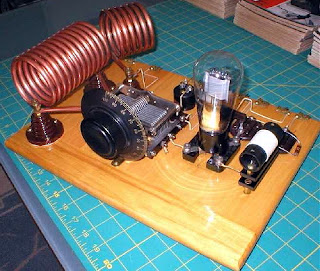 |
| VE3AWA - 210 TNT |
These stations were worked on weekend #2 ... Hartley oscillators having the edge once again.
40m
W7LNG TNT 10w OR
W8KGI MOPA 10w NM
N2BE Hartley 10w NJ
W2LB Hartley 5w NY
80m
VE3AWA TNT 10w ON
N3GJ Hartley 9w PA
W2LB Hartley 5w NY
KØKP Hartley 10w MN
KØKCY MOPA 10w MN
160m
KK7UV Hartley 10w MT
Please do consider putting something together for next year's BK Party as more new activity, particularly from the western side of the continent, is always wonderful to see and adds much more excitement to the party.
You might find the three-part 'Building '29 Style' links on the right sidebar of some interest should you be planning on joining the fun and ... if you are looking for help, you will find many '29 ops willing to do what they can to get you BK-ready on Yahoo's AWAGroup. Everyone would love to work you next year!
 ’29 BK QSO Party – Night #1
’29 BK QSO Party – Night #1
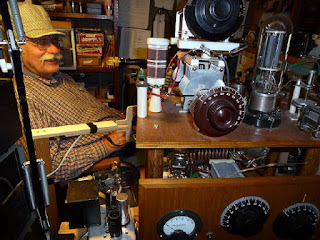 |
| Harold - KB0ROB |
This past Friday night's wonderful propagation during the ARRL 160m CW Contest, pretty much went into the dumper for Saturday night's 1929 Bruce Kelley QSO Party, sponsored by the Antique Wireless Association.
In spite of the auroral-like conditions, with the K-index reaching level '5', the melodic tones from many of the old (and new) clunkers could be heard pounding out their annual 'CQ AWA' invitations.
Among my 19 contacts (8 on 40m and 11 80m), the highlight of the night was working W2ICE/1 in Maine on both 40 and 80m. In reality, this was Paul, N1BUG, operating Bruce Kelley's original 10 watt TNT, which rose to almost S9 levels on 40m, once the sun had set. The Kelley transmitter is moved to various locations each year, a new AWA tradition.
As well, Larry (NE1S), also in Maine, was worked on 40m with his 10W TNT.
A new station for my '29 logbook was George (N3GJ), in Pennsylvania. George was managing 8 watts input to his version of a 1929 TNT.
When I first tuned-in, several years ago, to hear what these 1929 signals sounded like, two of the best sounding signals were coming from KBØROB (Harold), shown at the top, and KBØMM (Burt), both in Minnesota. I could hardly believe they were using era-appropriate rigs as their signals sounded as good as many modern rigs. Thankfully nothing has changed, as these two stations continue to hand out 'MN' using their well-built 'MOPA'-style time machines.
Scott, WA9WFA, the BK score-keeper in charge of logs, faded up briefly with his fine-looking Colpitts.
Here is a list of the '29ers worked so far, along with their rig style and DC power inputs.
40m
KK7UV Hartley 10w MT
W2ICE/1 TNT 10w ME
NE1S TNT 10w ME
VE7BDQ Colpitts 8w BC
K7SF Hartley 10w OR
K4JYS Hartley 10w NC
WB2AWQ Hartley 10w NV
N3GJ TNT 8w PA
80m
KBØMM MOPA 8w MN
KBØROB MOPA 9w MN
W7LNG TNT 7w OR
K4JYS Hartley 10w NC
W2ICE/1 TNT 10w ME
WA9WFA Colpitts 20w MN
KK7UV Hartley 10w MT
W9TFC Hartley 10w WI
N2BE Hartley 10w NJ
KIØDB MOPA 10w MN
WØLGU MOPA 10w MN
As you can see, 'Hartley' construction takes a slight edge. Vintage 'handbooks' and magazine articles from the era, have always promoted the TNT as the best 'beginners' rig but in reality, the Hartley is much easier to build and to get working with a good-sounding signal. The TNT requires some finicky tweaking of the grid coil in order to have an equally stable-sounding note.
I'm happy to report that in spite of the very high winds (as usual), my new MOPA's tone remained virtually unmoving ... for the most part! This was its first real workout and after my first QSO on 80m, my frequency began making large jumps and suddenly sounding very unstable, along with fluctuations in power output. My initial thought was that one of the old original mica caps was starting to breakdown.
After disconnecting one lead of each capacitor (one at a time) and temporarily clipping in a modern substitute, I was no further ahead. I had originally isolated the frequency instability to the amplifier stage and there was only one thing left ... the amplifier's grid-leak resistor. It appeared to be slowly failing, by increasing resistance in jumps. The 12K resistor was now measuring ten times that value and quickly rising. A new 12K, temporarily clipped in place, cured the problem but it had cost me over an hour of operating time ... probably the best prop of the night as by the time I got back on the band, signals were weak and auroral-sounding.
Hopefully the bands will have mended themselves by next Saturday night, allowing some of the smaller eastern stations to make it back to the west coast for some memorable '29 'transcons'.
 ARRL 160 CW / ’29 QSO Party
ARRL 160 CW / ’29 QSO Party
 |
| '29 MOPA |
I spent about five hours last night in the ARRL 160 CW contest, working 321 stations in 74 sections. Conditions were excellent, with my 150W sustaining long runs and big pileups. It reminded me very much of the old F2 days on 6m, running huge pileups of JA's. Unfortunately I'll not be able to continue tonight because of the conflict with the '29 QSO Party.
In reality, I may not be in that one either, as right on schedule the winds have picked up once again, with gusts to 83 km/h predicted throughout the day ... I'll be lucky if the power stays on for the QSO Party tonight. As well as doing their best to blow my antennas around and make my already shaky '29 signal sound even worse, these high winds all too often result in long power outages here in the Southern Gulf Islands ... my fingers are crossed, as they are every year at this time.
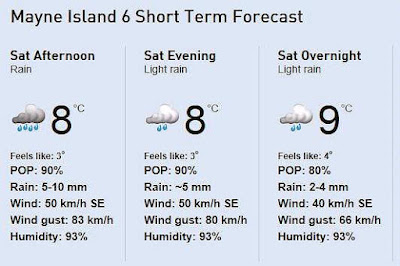 |
| courtesy: http://www.theweathernetwork.com/weather/canada/british-columbia/mayne-island-6 |
If I'm lucky enough to still have power, this will be the inauguration of my newly-constructed MOPA '29 rig ... a two-tube, Master Oscillator Power Amplifier. This rig will be much more 'wind-proof' than my previous mainstays, a single-tube TNT or the Hull Hartley. Both of these self-excited oscillators sound overly 'melodic' when directly coupled to an antenna swinging, or more often, blowing like crazy, in the wind.
If you ever wondered what the ham bands may have sounded like back in 1929, have a listen this Saturday as well as next Saturday night. You will hear some amazingly good signals being generated by these '29 state-of-the-art transmitters as well as some pretty awful sounding ones. It was the pretty awful-sounding ones that led to the crackdown for amateur radio in 1929 as hams were forced to clean up their act or suffer the consequences.
Activity will gather around 3550-3580 kHz and 7100-7125 kHz ... the second weekend will see some meet on the very low end of 160m for an hour, probably around 0400z. I hope some of you will be joining the fun as well, with your newly-constructed 'old' rig!
 The 1929 ‘BK’ QSO Party
The 1929 ‘BK’ QSO Party
 The month of December will soon be upon us and that means it's 'BK' time once again! The Bruce Kelley 1929 QSO Party is the annual two-weekend event celebrating the sound of amateur radio as it was in 1929.
The month of December will soon be upon us and that means it's 'BK' time once again! The Bruce Kelley 1929 QSO Party is the annual two-weekend event celebrating the sound of amateur radio as it was in 1929.At no other time of the year can you tune across the bands and hear the melodic sound of radio as it once was ... before the days of crystal-control, when most hams were using self-excited one or two-tube transmitters.
With antennas blowing in the wind, these directly-coupled oscillators often make the band sound like a musical symphony gone wrong ... the wonderful whooping, chirping, buzzing, clicking, drifting, swishing, swaying, warbling, and other interesting sounds of '29, when amateur radio was in its infancy.
If you've ever considered joining-in on the fun, then you still have a few weeks to slap something together for the party ... it need not be 'pretty', but it must be 'compliant'. That is, the tube (or tubes) that you use, must have been available in 1929 or earlier. For receiving, use anything you like ... modern or vintage, as there are no restrictions.
I've penned several blogs on popular circuits and tubes that are commonly used among the BK regulars and they can be viewed here:
Building '29 Style
Building '29 - What To Build? - PT.1
Building '29 - What To Build? - PT.2
More BK Building
With the usual propagation of early December, it is not surprising that many transcontinental QSO's are made every year, even with the little two or three watters. Considering the 10 watt power input rule, it is surprising how strong some signals from across the country can become on the lower bands, especially on 40m.
Please consider rolling-up your sleeves, heating up your soldering iron and putting something together for the BK fun, especially if you are on the left coast ... and don't be the least concerned about how it looks!
For a gallery of inspiration from individuals that were too weak to resist the temptation, have a look at some previously built '29 time machines.
For the first time, I'll be using my newly constructed MOPA, a two-tuber that will hopefully reduce my annual BK windstorm angst. It seems that every BK weekend, I have gale-force winds here on the island, making my signal a little bit 'too musical', although some '29 diehards still claim to love the sound ... for them, there is no hope.
 1929 BK QSO Party Fun
1929 BK QSO Party Fun
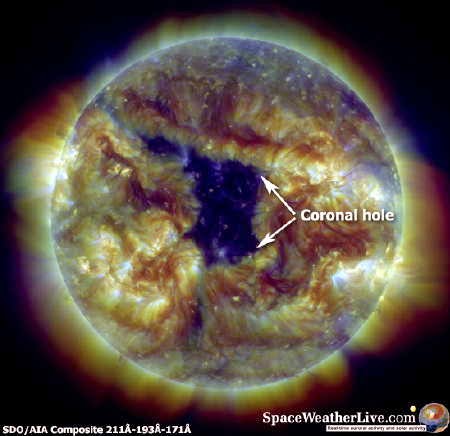 |
| Courtesy: http://www.spaceweatherlive.com |
Not to disappoint, the usual BK winds came up, right on schedule as well, almost coincidental with the start of the Party. Thankfully, weekend number two saw no wind whatsoever....a rare event in December....but, from the sound of many other notes, I wasn't the only one having windy weather.
Some of this year's highlights were working my usual "must contact" stations back east....N1BUG (Paul, in Maine), NE1S (Larry, also in Maine), VE3AWA (Lou, in Ontario), K4JYS (Bill, in NC) and WØVLZ (Niel, in MN). It's particularly fun to work Niel as it was the fine Youtube video of his 1929 station that got me started in vintage building.
Two newcomers made this affair even better, with the addition of John, VE7BDQ,along with his nice three-band Colpitts and 12-year old Joe, KC9WYV, operating at KBØROB's station in MN. He has a fist as smooth as silk and will be a wonderful asset to our hobby. Kudos to Harold for the "Elmering" of this young ham.
I made a very short recording of 40m early on the first weekend, just after the 3PM start.... but there wasn't much to hear at this early hour. On the video below you can see (and hear) the signals of (in order): K4JYS (NC) being answered by KK7UV, W7LNG (OR), WB2AWQ (Reno, NV), VE7BDQ (working WA1JAS in Maine). The 8W signal of WA1JAS is amazing, considering the hour....still daylight here on the west coast.
My BK log is rather skimpy, considering that it represents two Saturday-nights of activity. In terms of fun, it is very much larger. I rather suspect that this may have been the last outing for my Hull Hartley, as work has now begun on a MOPA rig for next year....hopefully I won't have to worry about the wind weather any longer!
Of particular interest are the rig descriptions and input power levels. I also see Hartley's having a slight-edge over TNT's in terms of usage. It was disappointing to have only 3 contacts on topband, but conditions were just not going to let it happen....maybe next year.
DE6 2302 40 KK7UV 589c 558 HART 28 9 STEVE MT
DE6 2317 40 N1BUG 568 449 TNT 29 10 PAUL ME
DE6 2322 40 WA1JAS 569 559 HART 29 8 MIKE ME
DE6 2347 40 W7LNG 567 578 TNT 29 6 BUD OR
DE6 2352 40 VE7BDQ 599 599 COLP 29 10 JOHN BC
DE7 0014 40 K7SF 578 579 TNT 29 10 STEVE OR
DE7 0105 40 NE1S 449 449 TNT 29 9 LARRY ME
DE7 0120 40 WB2AWQ 579 569 HART 29 10 HOWIE NV
DE7 0133 40 K4JYS 449 449 TNT 29 10 BILL NC
DE7 0145 40 WB8APR 559 449 MOPA 29 5 JOHN MI
DE12 2257 40 K0KP 579 559 HART 29 9 REX MN
DE6 0202 80 AB0CW 559 549 HART 29 5 MARK CO
DE6 0317 80 KK7UV 599 599 HART 28 9 STEVE MT
DE6 0329 80 KE0Z 559 559 HART 29 8 WILL SD
DE6 0356 80 N1BUG 449 559 TNT 29 10 PAUL ME
DE6 0403 80 KC9WYV 579 539 MOPA 29 9 JOE MN
DE6 0415 80 VE7BDQ 599 599 COLP 29 10 JOHN BC
DE6 0422 80 AA2YV 439 449 HART 29 10 BILL NY
DE6 0438 80 N8YE 559 569 TPTG 25 9 STEVE OH
DE6 0442 80 W7LNG 578 588 TNT 29 9 BUD OR
DE6 0524 80 K0KP 599 589 HART 29 9 REX MN
DE6 0530 80 W2ICE/0 579 339 COLP 29 10 SCOTT MN
DE6 0539 80 VE3AWA 578 339 TNT 29 10 LOU ON
DE6 0548 80 KI0DB 559 579 MOPA 29 10 MARK MN
DE6 1229 80 W0LGU 559 559 MOPA 29 9 TOM MN
DE6 1240 80 K0KCY 559 449 MOPA 29 10 TONY MN
DE12 0352 80 KB0ROB 569 569 MOPA 29 9 HAROLD MN
DE12 0427 80 W8KGI 559 448 MOPA 29 10 JIM NM
DE12 0440 80 W0VLZ 559 339 TNT 29 10 NIEL MN
DE12 0509 80 K4JYS 559 559 HART 29 15 BILL NC
DE12 0512 80 WB9WHG 569 449 MOPA 29 20 DAVE WI
DE12 0524 80 W0LS 599 579 HART 29 9 HARRY MN
DE12 0401 160 KK7UV 579 559 HART 28 10 STEVE MT
DE12 0539 160 VE7BDQ 599 599 COLP 29 10 JOHN BC
DE12 0542 160 W0LS 559 559 HART 29 9 HARRY
DE6 2317 40 N1BUG 568 449 TNT 29 10 PAUL ME
DE6 2322 40 WA1JAS 569 559 HART 29 8 MIKE ME
DE6 2347 40 W7LNG 567 578 TNT 29 6 BUD OR
DE6 2352 40 VE7BDQ 599 599 COLP 29 10 JOHN BC
DE7 0014 40 K7SF 578 579 TNT 29 10 STEVE OR
DE7 0105 40 NE1S 449 449 TNT 29 9 LARRY ME
DE7 0120 40 WB2AWQ 579 569 HART 29 10 HOWIE NV
DE7 0133 40 K4JYS 449 449 TNT 29 10 BILL NC
DE7 0145 40 WB8APR 559 449 MOPA 29 5 JOHN MI
DE12 2257 40 K0KP 579 559 HART 29 9 REX MN
DE6 0202 80 AB0CW 559 549 HART 29 5 MARK CO
DE6 0317 80 KK7UV 599 599 HART 28 9 STEVE MT
DE6 0329 80 KE0Z 559 559 HART 29 8 WILL SD
DE6 0356 80 N1BUG 449 559 TNT 29 10 PAUL ME
DE6 0403 80 KC9WYV 579 539 MOPA 29 9 JOE MN
DE6 0415 80 VE7BDQ 599 599 COLP 29 10 JOHN BC
DE6 0422 80 AA2YV 439 449 HART 29 10 BILL NY
DE6 0438 80 N8YE 559 569 TPTG 25 9 STEVE OH
DE6 0442 80 W7LNG 578 588 TNT 29 9 BUD OR
DE6 0524 80 K0KP 599 589 HART 29 9 REX MN
DE6 0530 80 W2ICE/0 579 339 COLP 29 10 SCOTT MN
DE6 0539 80 VE3AWA 578 339 TNT 29 10 LOU ON
DE6 0548 80 KI0DB 559 579 MOPA 29 10 MARK MN
DE6 1229 80 W0LGU 559 559 MOPA 29 9 TOM MN
DE6 1240 80 K0KCY 559 449 MOPA 29 10 TONY MN
DE12 0352 80 KB0ROB 569 569 MOPA 29 9 HAROLD MN
DE12 0427 80 W8KGI 559 448 MOPA 29 10 JIM NM
DE12 0440 80 W0VLZ 559 339 TNT 29 10 NIEL MN
DE12 0509 80 K4JYS 559 559 HART 29 15 BILL NC
DE12 0512 80 WB9WHG 569 449 MOPA 29 20 DAVE WI
DE12 0524 80 W0LS 599 579 HART 29 9 HARRY MN
DE12 0401 160 KK7UV 579 559 HART 28 10 STEVE MT
DE12 0539 160 VE7BDQ 599 599 COLP 29 10 JOHN BC
DE12 0542 160 W0LS 559 559 HART 29 9 HARRY
More information on '29 building may be found here in previous "'29-style blogs" and good project discussions always abound at the Yahoo "AWA Group" builder's site.
It's really not too early to start building for next year's BK!
